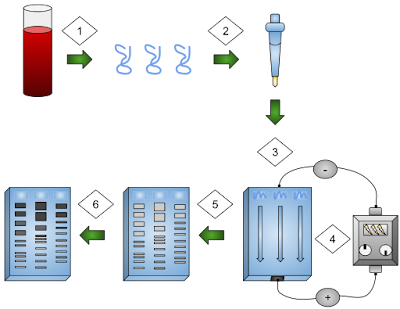DNA fingerprinting:-
DNA fingerprinting which is also known
as DNA profiling, genetic fingerprinting, DNA typing etc. DNA fingerprinting
came into picture in 1984 when Alec Jeffrey noticed that there was a highly
variable DNA sequence or highly variable DNA repeats in between the genes. And
this variable repeats or this variable DNA is unique for each and every
individual that gives an idea that DNA can tell a lot about an individual also
you can also look into the DNA and say that one person is related to another.
So what essentially
this mean in humans when we take a linear sequence of DNA?
We know that we contain multiple
genes. All these genes are going to be the same for all the individuals the
same as there will be different copies of these genes or different alleles of
these genes present in the different individuals. Now in between these genes we
have a non-coding region in the DNA, this is what we used to call as junk DNA but now we know that it is very important. Now this non-coding region is the
one which shows very high variability. The region in between genes where
we see high variability, is highly variable in each and every individual. Now
in this non-coding region we will see repeats of the DNA letters multiple times
say for example there is G, A, T,A sequence and this sequence will be repeated
over and over again maybe like 10 times twenty times fifty times hundred times
this is very unique for each and every individual. That multiple repeats of
some short DNA sequences present is called short tandem repeats.
This short tandem repeats or
what we call STR's are very unique for each and every individual so this
non-coding region of DNA contains multiple short tandem repeats.
DNA fingerprinting actually utilizes
this property. We will see what exactly or how exactly this helps. Say for
example we have three different individuals. we have individual 1 2 & 3 as
we know they will all have the same gene that means different allele or
different copies of the gene but the difference will be in the non-coding region.
There is a repetitive short sequence which is present and that differs in every
digit so we know for individual 1 this STR sequence is repeated for quite a
number of time it maybe big but for individual number 2, the STR is different
and same for individual 3 it is very different. So we can say in each and every
non-coding region it differs for every individual. This is what the concept is
telling that STR are highly variable. DNA short tandem repeats are different
for every individual and that is going to give us the fingerprinting.
What is the
mechanism of DNA fingerprinting? how it is going to utilize this STR and give
you a profiling ?
 |
| gel electrophoresis |
So what we do for DNA
fingerprinting is we will cut these STR's using restriction enzyme that
would be the first step. Once we isolate these short tandem repeats or STR, we
are going to multiply them or increase them in number using polymerase chain
reaction or PCR. Once we have good amount of sample, we are going to separate
these using gel electrophoresis. Now we know that we can separate DNA on the
agarose gel. Hence we are going to separate them using gel electrophoresis. AS
DNA is negatively charged it is going to get pulled towards the positive
charge. So based on the size of the STR of that particular segment it is going
to get separated. This is how it is going to separate for all three
individuals.
Looking at the above separation pattern in the image,
this is called as the fingerprinting of that particular individual.
Now how is this
going to help us? what are the applications of this?
 |
| Understanding How DNA Fingerprinting Is Done in Forensics |
DNA fingerprinting can help us in forensic to solve a crime or for paternity test. So let's take one example and see the application of DNA fingerprinting. Let's take a murder case and see how we can utilize DNA fingerprinting to solve a murder scene. Say for example we have got a blood sample at a murder site which is not of the victim but it is of some others blood sample and we have three suspect. what we're going to do is we're going to take sample from all three suspects and the sample that we have got at the murder site, we run it on agarose gel and what we get is a fingerprint something like all the segments based on their size have got separated on the gel. Hence by matching the STR sequence with that of the suspects we can determine the killer. The principle being that the STR of the sample matches with the STR sequence of the suspect. And so this is how DNA fingerprinting helps.
Solving paternity cases
This is also helpful for solving
paternity case to find out the biological father of a child. You can take the
sample of the child and the father and you can run the similar tests. If you
see the similarities in the STR region, you can conclude that he is the
rightful father of that child. So that's how DNA fingerprinting works.








0 Comments
Please feel free to ask any queries regarding the topic in comments section below